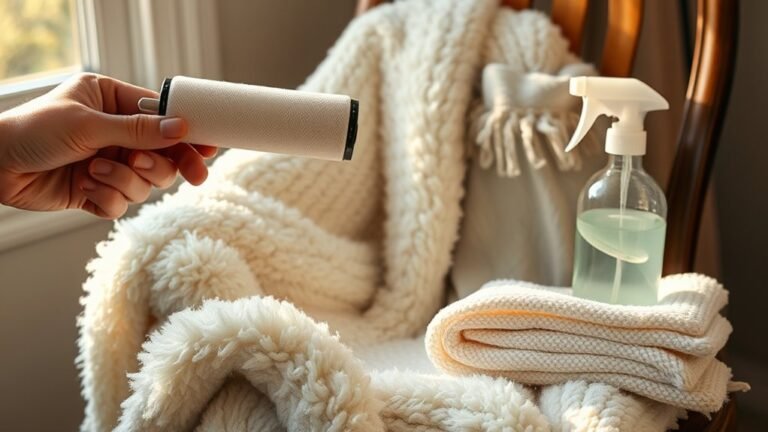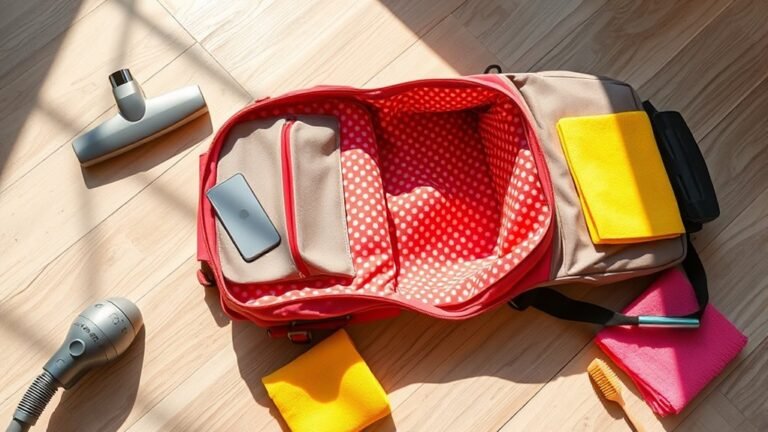Tips for Cleaning With Ultraviolet (UV) Light Sanitizers
When using a UV light sanitizer, make sure to prep surfaces by wiping off any dirt since UV light can’t penetrate grime. Hold the device at the recommended distance, moving it slowly to cover all areas while following exposure time guidelines for effective germ-killing. Protect your eyes and skin with proper safety gear and avoid direct light exposure. Regularly clean the UV bulbs and store the device properly to keep it working well. Keep going to discover how to choose the right sanitizer and maximize its benefits.
Understanding How UV Light Sanitizers Work

Although UV light sanitizers might seem like futuristic gadgets, they actually use a simple principle: ultraviolet light disrupts the DNA or RNA of microorganisms, preventing them from reproducing and effectively killing them. When you use UV light technology, you’re tapping into its powerful germicidal properties to eliminate bacteria, viruses, and other pathogens without chemicals. This means you can enjoy a cleaner environment while maintaining your independence from harsh cleaners or complicated methods. By understanding how UV light targets and deactivates harmful microbes, you gain control over your space’s hygiene on your terms. It’s a straightforward, efficient way to protect yourself and those around you, giving you the freedom to keep things safe with minimal effort and maximum effectiveness.
Choosing the Right UV Sanitizer for Your Needs
How do you pick the right UV sanitizer for your specific needs? Start by exploring the different types available—wand, box, or station models—each designed for unique uses and spaces. Think about what you want to sanitize most often: small gadgets, large surfaces, or even air. User reviews are invaluable here; they reveal real-world performance, durability, and ease of use beyond specs. Pay attention to feedback regarding battery life, safety features, and effectiveness. Choosing a UV sanitizer that fits your lifestyle means balancing portability with power and coverage. By focusing on these factors, you guarantee your new gadget offers freedom from germs without complicating your routine. Trust in the experiences of others to guide you toward the best fit for your daily sanitation needs.
Preparing Surfaces and Items for UV Cleaning

Before using your UV sanitizer, you’ll want to remove any visible dirt or debris from surfaces and items to guarantee effective cleaning. Arrange the items so that UV light can reach all areas evenly, avoiding overlaps or shadows. Proper preparation helps maximize the sanitizer’s effectiveness.
Remove Visible Dirt
Since UV light sanitizers work best on clean surfaces, you’ll need to remove any visible dirt or grime first. Visible dirt removal is essential because UV light can’t penetrate through layers of soil or debris. If you skip this step, you’re limiting the sanitizer’s ability to reach and destroy germs effectively. Grab a cloth or sponge and use a gentle cleaner to wipe down the area or item until it looks clean. This simple step guarantees effective cleaning by allowing the UV light to do its job without interference. Taking the time to prep surfaces with visible dirt removal gives you the freedom to rely on your UV sanitizer for thorough disinfection every time.
Arrange Items Properly
Properly arranging items is one of the most important steps to guarantee your UV light sanitizer works effectively. When you set up your items, think about how UV light travels—direct exposure is key. Avoid overcrowding or overlapping objects, as shadows can block the light and reduce sanitizing power. Focus on item arrangement by spacing things out evenly, allowing light to reach every surface. Use smart stacking techniques; for example, place smaller items on top or to the side, ensuring nothing is hidden beneath. If your sanitizer includes a rotating feature, arrange items so they can move freely without blocking each other. By mastering these simple item arrangement and stacking techniques, you’ll maximize your sanitizer’s efficiency and enjoy a cleaner, healthier space without restrictions.
Proper Usage Techniques for Maximum Effectiveness
To get the best results from your UV light sanitizer, you’ll need to follow specific exposure duration guidelines carefully. Keeping the device at the ideal distance from the surface is just as important to guarantee effective sanitization. Let’s explore how timing and placement work together for maximum effectiveness.
Exposure Duration Guidelines
One key factor in getting the most out of UV light sanitizers is understanding how long you should expose surfaces to the light. Exposure time directly impacts the sanitizer’s effectiveness, but it varies based on light intensity. To maximize freedom from germs, keep these guidelines in mind:
- Higher light intensity means shorter exposure time.
- Lower intensity requires longer exposure to guarantee thorough sanitization.
- Follow manufacturer recommendations for specific exposure durations.
- Avoid rushing; insufficient exposure time reduces effectiveness.
Optimal Distance Placement
Although exposure time is essential, the distance between the UV light sanitizer and the surface you’re cleaning plays an equally important role in its effectiveness. You need to pay close attention to distance measurement to guarantee the UV rays reach their target with enough intensity. Too far, and the light weakens; too close, and you risk damaging sensitive materials. A smart placement strategy involves positioning the device within the manufacturer’s recommended range, usually just a few inches from the surface. Move the sanitizer slowly and steadily to cover every area evenly. By mastering this balance, you maximize your sanitizer’s power without wasting time or energy. Remember, freedom in cleaning means using your tools right, so embrace this precise placement approach for the best results.
Safety Precautions When Using UV Light Devices

When using UV light devices, you need to take specific safety measures to protect your skin and eyes from harmful exposure. UV light safety is essential, so don’t skip personal protective equipment like goggles and gloves. To stay safe while enjoying the freedom UV sanitizers offer, follow these steps:
- Always wear UV-blocking eyewear to shield your eyes.
- Use gloves or cover your skin to prevent burns.
- Never look directly at the UV light source.
- Operate the device in unoccupied spaces to avoid accidental exposure.
Maintaining and Caring for Your UV Sanitizer
After taking the necessary safety precautions, you’ll want to guarantee your UV sanitizer stays effective over time. Regular maintenance is key—clean the UV bulbs gently with a soft cloth to remove dust and fingerprints, which can block light and reduce efficiency. Always unplug the device before cleaning. Avoid harsh chemicals; a mild soap solution works best. For sanitizer storage, keep your device in a cool, dry place away from direct sunlight to preserve bulb life and prevent damage. Store it where it won’t get knocked over or exposed to moisture. Following these maintenance tips assures your UV sanitizer performs reliably, giving you the freedom to keep your space germ-free without hassle. Consistent care extends your device’s lifespan while maintaining its powerful sanitizing ability.
Frequently Asked Questions
Can UV Light Sanitizers Kill All Types of Bacteria and Viruses?
You might think UV light sanitizers are like a modern-day Excalibur, cutting through all germs effortlessly. However, they don’t kill every single bacteria or virus out there. Some bacteria show resistance, and virus mutations can alter how effective UV light is. While UV sanitizers offer powerful protection, they’re not a flawless shield. To truly claim your freedom from germs, it’s wise to combine UV light with other cleaning methods.
How Long Does UV Light Sanitization Take to Be Effective?
When you’re wondering about UV light effectiveness timing, it usually depends on the device and the surface. Most UV sanitizers need anywhere from 10 seconds to a few minutes to achieve proper sanitization duration. You’ll want to follow the manufacturer’s instructions closely since too short exposure won’t kill germs effectively, while too long might be unnecessary. Stick to these guidelines, and you’ll enjoy the freedom of a cleaner, safer environment in no time.
Are UV Light Sanitizers Safe for Use on Electronics?
Wondering if UV light sanitizers are safe for your electronics? When used correctly, they can effectively eliminate germs without harming your devices, ensuring electronic safety. But you’ve got to be cautious—overexposure or direct contact with sensitive screens might cause damage. So, isn’t it worth balancing UV effectiveness with careful use? By following manufacturer guidelines, you can enjoy freedom from germs while keeping your gadgets in top shape.
Can UV Light Penetrate Glass or Plastic Surfaces?
You might wonder about UV light penetration through surfaces like glass or plastic. Usually, UV light struggles to pass through thicker glass or certain plastic barriers, limiting its effectiveness beneath these layers. The type and thickness of the surface matter a lot—some plastics block UV rays more than others. So, if you want UV light to work freely, it’s best to expose it directly or use materials that let the light through easily.
Do UV Light Sanitizers Work on Fabric and Clothing?
You might wonder if UV light sanitizers work on fabric materials like clothing. They can be effective, but UV light doesn’t always penetrate deeply into thick or layered fabrics, so the cleaning methods may need more time or multiple passes. For best results, you’ll want to expose your clothes evenly and avoid shadows. Combining UV sanitizing with traditional washing gives you the freedom to keep your fabrics truly fresh and germ-free.






